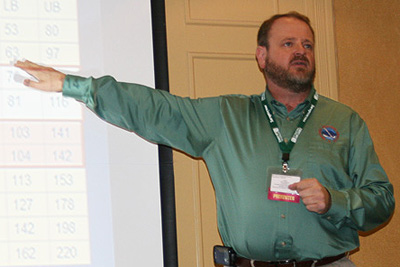
"Applying lessons learned from structural performance is a fundamental step toward protecting lives and property in future disasters," said Code Council Chief Operating Officer Dominic Sims, who moderated the event. "It was critical we bring together experts from across the spectrum to examine the storms, to share ideas, and to implement plans to strengthen communities for the next natural disaster."
 |
|
|
• When It Rains It Pours by Alan Boswell, Chief Building Official for the city of Tuscaloosa.
• Tornado Threat Assessment and Damage Analysis by John DeBlock (pictured left), Warning Coordination Meteorologist, National Weather Service.
• Tornado Facts and Effects of Wind by Sam Hensen, P.E., Regional Manager of Engineering, Simpson Strong-Tie Company.
• Safety Assessment by Trained Professionals by James E. "Butch" Grimes, Architect, Grimes+Architects, State of Alabama AIA Disaster Assistance Coordinator.
• Damage Study and Future Direction for Structural Design Following the Tuscaloosa Tornado of 2011 by John van de Lindt, Ph.D., Professor and Gary Neil Drummond Endowed Chair in Civil Engineering, University of Alabama.
Boswell said Tuscaloosa's updated Disaster Response Plan has been critical since an EF-4 tornado struck the city on April 27. "Always keep your plan updated within a five-year period," he advised. "More than 200 of our businesses were destroyed during the storm, and that's a major revenue stream for any city. And even though 9-12 percent of our city was gone, we still had 88-91 percent of our city to serve."
DeBlock (pictured) was part of a team of National Weather Service experts that performed damage assessments following April's outbreak of tornadoes in Alabama. Based on the team's findings, he said the adoption and enforcement of updated building codes and sheltering are two keys to protecting lives and property in future storms. "I don't know of any construction codes and standards that can survive an EF-5 tornado, and that's when we should turn to storm shelters," he said. "When we do, we're going to worry about getting people to the shelters, and we need you to help us make sure we have somewhere to go."
In addition to storm shelters, building safety measures already exist for high-wind regions across the country. One example is ICC 600: Standard for Residential Construction in High-Wind Regions that provides an adoptable, contemporary set of prescriptive requirements and other details for construction of buildings sited in wind climates of 100-150 mph in 10 mph increments.
"Building safety professionals will take this information and they'll incorporate it into the work they do, whether it is the design of new buildings or whether it is the development of new building codes," Sims said.
Added van de Lindt: "I hope the residents will see that the design and code community is taking this very seriously."
Video highlights are available from the symposium:
• Boswell, When It Rains It Pours
• DeBlock, Tornado Assessment and Damage Analysis
• van de Lindt, Damage Study and Future Direction for Structural Design
• Hensen, Tornado Facts and Effects of Wind
• Panel Discussion